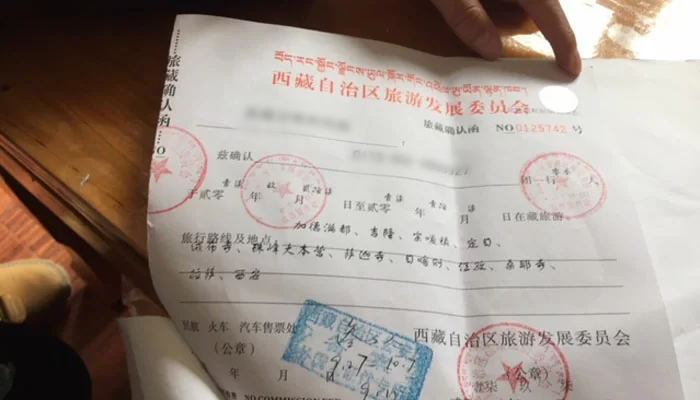Tibetan food, like Tibet’s own culture and religion, has its own unique characteristics. Growing at such a high altitude and in a harsh climate, what to eat and drink in Tibet is quite different from other places. Generally, vegetables and fruits are hard to find on the Tibetan plateau. Daily diets for most Tibetans include Tsampa, butter tea, yak meat, and mutton, among other dishes.
Some tourists who can't get used to the taste of Tibetan food have spoken poorly of Tibet's traditional cuisine, while others have found that Tibetan cuisine is acceptable and not as bad as people have said. Whether it's delicious or not, you can give it a try while traveling to Tibet.
What is the Traditional Tibetan Food?
Tsampa
Tsampa is the staple food in Tibet, and Tibetan people consume it three times a day. Typically, Tibetans grind parched barley into fine flour and mix it with salty Tibetan butter tea to create salty tsampa. You can also enjoy sweet tsampa by making porridge with meat, vegetables, and sugar. Due to its simple cooking process, it has become an instant food for Tibetans, especially for pilgrims trekking to Mount Kailash.
 Tibetan people eat Tsampa every day.
Tibetan people eat Tsampa every day.In its natural state, Tsampa is extremely chalky and powdery, so Tibetans use a trick called Tsang-gam to eat it. According to this trick, you should avoid inhaling while eating Tsampa, as failing to do so might lead to a choking fit.
Modernized versions of Tsampa have emerged to cater to more refined palates. The Tsampa you'll find in Tibetan eateries today is quite different from the original version. It is sweet and smooth and is often served with pickles, hot sauce, or other condiments of your choice. Nevertheless, it remains delicious and well worth a try.
Air Dried Meat
Air-dried meat is another special Tibetan food, popular in Tibet and typically made from beef and mutton. Tibetans often prepare air-dried meat at the end of the year when the temperature drops below freezing. Yak and sheep meat are cut into strips and then hung in dry, well-ventilated places. You must try air-dried meat for its purity and unique Tibetan taste.
 Air dried meat is made from beef and mutton.
Air dried meat is made from beef and mutton.Tibetan Sausages
Tibetan sausage, created by nomads, has a history dating back one thousand years. The stuffing, blended with essential ingredients such as salt and pepper, is piled into fresh animal intestines. Depending on the type of stuffing used, Tibetan sausage can be classified into various categories, including blood sausage filled with sheep's blood, meat sausage with dog meat, liver sausage with animal liver, and more. Whether steamed or roasted, Tibetan sausage will never disappoint.
 Tibetan blood sausage has a history of one thousand years.
Tibetan blood sausage has a history of one thousand years.Tibetan Momos
Tibetan momos are quite delicious and are similar to Chinese dumplings (Jiaozi) or steamed stuffed buns (Baozi). A small piece of rolled-out dough is filled with either beef or mutton seasoned with ginger, garlic, and a variety of spices, and then wrapped up. Just 15 minutes later, you can enjoy the fried or steamed momos with pepper sauce.
 There are many types of Tibetan momos.
There are many types of Tibetan momos.There is a wide variety of different types of momos for you to try in Tibet. For example, tsi-tsi momos are shaped like mice and are added to a soup called mothuk. There are momos of different sizes, shapes, and flavors.
Tibetan Noodles
Tibetan noodles usually go well with simple vegetables and meat. The taste largely depends on the flavorings. Thick noodles, big slices of meat, and tasty soup make it prevail among Tibetan women and kids.
 Tibetan noodles usually go well with simple vegetables and meat.
Tibetan noodles usually go well with simple vegetables and meat.Tibetan Cheese
Dri milk can be used to prepare curds and cheeses, which are popular ingredients in Tibetan cuisine. A specific type of cheese known as Churpi is made from solidified yogurt, cut into small cubes, and strung on necklaces made from yak wool. These cubes serve as a kind of candy for travelers, as it can take hours to finish just one cube. However, this unique type of cheese candy is not for everyone, as most people dislike Churpi due to its hardness and distinctive taste.
 Tibetan cheese is popular in Tibetan cuisine.
Tibetan cheese is popular in Tibetan cuisine.Tibetan Tea
Tibetan tea can be divided into Tibetan butter tea and Tibetan sweet tea. Tibetan butter tea is another staple of Tibetan meals and is usually served with Tsampa. It's made by boiling tea with ghee and salt. Tibetan people drink it throughout the day to keep themselves warm from the heart to the foot and to ward off fatigue.
 Tibetan sweet tea is widely accepeted among tourists.
Tibetan sweet tea is widely accepeted among tourists.Although this drink is popular among locals, tourists might not find it appealing at first. In comparison, Tibetan sweet tea (also known as Tibetan milk tea) is more popular and widely accepted among tourists. Adding sugar to brick tea and boiled milk makes it more palatable and less characteristic of traditional Tibetan tea. This drink is similar to ordinary tea and combines milk and sugar with the tea.
Tibetan Barley Wine
This is another standout drink found in Tibet. Tibetan barley wine, also known as Tibetan Chang, is brewed from highland barley. It typically has a slightly sweet and sour taste, and its flavor can vary depending on the brewing process and duration.
 Tibetan barley wine can have different flavors.
Tibetan barley wine can have different flavors.Tibetan Chang with a low alcohol content is well-liked by Tibetans, including both young and old, as well as both males and females. It's also served at various festivals and other important occasions, and there's a good chance that you'll be offered Tibetan barley wine by enthusiastic Tibetans.
Where to Find Authentic Tibetan Food in Tibet?
If you're planning to taste Tibetan food during your plateau trip, there are various options to savor authentic flavors. Tibetan teahouses are a must-visit, offering traditional Tibetan butter tea, sweet tea, Tibetan noodles, Tsampa, and more.
Additionally, local Tibetan restaurants and select guesthouses provide excellent opportunities to enjoy authentic Tibetan dishes. Notable choices include the Tibetan Family Kitchen, Crazy Yak Saloon, Tibetan Cafeteria, Lhasa Kitchen, and others. Many of these Tibetan-style restaurants are conveniently located near the Jokhang Temple and along Barkhor Street.
 Authentic Tibetan food of Lhasa Tibetan Family Kitchen
Authentic Tibetan food of Lhasa Tibetan Family KitchenIf you're unsure where to experience genuine Tibetan cuisine, feel free to ask your tour guide for recommendations tailored to your preferences.
Are there other Food Options in Tibet?
For the occasional adventurous soul and those who are not used to traditional Tibetan food, there are many other food options to explore in Tibet.
You can delve into authentic Sichuan cuisine, known for its hot spices and aromatic flavors. Neighboring Tibet, many people from Sichuan open restaurants there to meet the needs of those seeking bold flavors. If you are not inclined to try new things, you will also find comfort food in Lhasa. Opt for Nepali or Indian dishes that suit your taste buds.
 Nepali dishes of Tibet Lhasa Kitchen
Nepali dishes of Tibet Lhasa KitchenThere are also plenty of vegetarian options in Lhasa, Shigatse, and other major cities of Tibet. You can find many restaurants offering vegetarian food like noodles, vegetables, and snacks.
Meanwhile, you will find some familiar chain restaurants of Western food in Tibet, such as KFC, McDonald's, etc., as well as cafes and Western-style pastry shops for you to choose from.
Are there some Forbidden Food in Tibet?
Yes, there are some dining taboos in Tibet due to religion and customs. As tourists new to the plateau, understanding the local dining taboos and avoiding them as much as possible can make our journey smoother. If you are not sure about the local taboos, you can ask your guide in advance.
Due to the influence of Tibetan Buddhism, Tibetans generally do not eat pork. Pigs are considered impure animals in Tibetan Buddhism, so pork is usually not found on their dining tables. In Tibetan Buddhism, fish is regarded as a sentient being with a soul, and as a result, some Tibetans adhere to Buddhist teachings and do not consume fish.
The meat of animals with cloven hooves, such as horses, donkeys, and mules, is forbidden in Tibet. This is because in Tibetan Buddhist culture, horses are considered sacred animals, while donkeys and mules are used for agricultural and transport work, making the meat of these animals taboo.
How about the Food Available at Everest Base Camp in Tibet?
The Everest Base Camp (EBC) in Tibet offers a convenient way to appreciate the stunning view of Mount Everest, making it a popular destination among tourists visiting Tibet. While there are plenty of food selections along the way from Lhasa to Everest Base Camp, the dining choices at the camp itself are limited.
 Tents at Everest Base Camp offer simple food.
Tents at Everest Base Camp offer simple food.At Everest Base Camp, the only dining options are tent restaurants run by locals. Here, you can enjoy traditional Tibetan dishes such as Tibetan noodles, Tsampa, Tibetan sweet tea, and more. Of course, the tent restaurants also offer simple Chinese dishes like rice porridge, fried rice, and basic stir-fries. With the development of tourism, you can also find simple hotpot dishes in tent restaurants at Everest Base Camp nowadays.
Besides, there are canteens providing various snacks, such as instant noodles, cola, biscuits, milk, ham sausage, highland barley wine, beer, etc. However, the prices of these foods are generally higher compared to those in lower-altitude cities and towns. If necessary, you can also bring some of your favorite food or snacks.
How about the Food Available at Mount Kailash in Tibet?
Trekking to Mount Kailash or completing the Kailash Kora is undeniably a physically demanding activity. To replenish your energy and vitality, there are tents along the way that sell nutritious food. While the options may be limited, you can almost always find Tibetan Butter Tea, Tsampa, and instant noodles available. These tents can also prepare dishes like fried noodles, egg-fried rice, green pepper and shredded beef fried rice, and more.
Furthermore, at the shops along the route, you can purchase very basic foods such as biscuits, ham sausages, drinks, beer, mineral water, and instant milk tea, among other items. Additionally, Drirapuk Monastery Guesthouse and Dzultripuk Monastery Guesthouse, serving as overnight stops for tourists, offer indoor restaurants with a variety of food options, including flatbreads, egg noodles, vegetables, ham sausages, and instant noodles.
Tips for Enjoying Tibetan Food during Your Tibet Tour
1. Respect cultural norms: When dining in Tibetan homes or at traditional gatherings, it's important to be respectful of local customs. Follow etiquette such as receiving and giving food or drink with your right hand and not sticking your chopsticks upright in a bowl of rice.
2. Adjust to high altitudes: Tibet is known for its high-altitude locations. Be mindful that digestion can be affected at higher elevations. Start with lighter meals and gradually indulge in richer dishes as your body acclimates.
3. Ask for recommendations: Seek recommendations from locals or your tour guide for the best places to eat. They can direct you to hidden gems and ensure you have a safe and enjoyable dining experience.
4. Stay hydrated: Due to the dry climate, it's important to stay hydrated. Pair your meals with Tibetan tea or fresh water to keep yourself feeling good throughout the day.
5. Beware of spiciness: Tibetan food can be spicier than you might expect. If you're not a fan of spicy food, ask for milder versions of dishes or check with the chef about the level of spiciness.
6. Enjoy the atmosphere: Tibetan restaurants often have a warm and cozy ambiance. Take your time to savor the food, enjoy the surroundings, and engage in conversation with fellow travelers or locals.
Conclusion
Exploring Tibetan cuisine while touring Tibet is an unforgettable part of your journey. You can indulge in traditional Tibetan food such as Tsampa, butter tea, yak meat, and Tibetan momos, among others. Alternatively, you have the opportunity to explore other cuisines, including Sichuan dishes and Western food available on the plateau.
Embrace the culinary diversity and savor the flavors during your Tibet trip, all while respecting the dining customs of the local people. If you have any questions or seek further information about Tibetan food, please don't hesitate to contact us.


























 Tibetan people eat Tsampa every day.
Tibetan people eat Tsampa every day.
 Air dried meat is made from beef and mutton.
Air dried meat is made from beef and mutton. Tibetan blood sausage has a history of one thousand years.
Tibetan blood sausage has a history of one thousand years. There are many types of Tibetan momos.
There are many types of Tibetan momos. Tibetan noodles usually go well with simple vegetables and meat.
Tibetan noodles usually go well with simple vegetables and meat. Tibetan cheese is popular in Tibetan cuisine.
Tibetan cheese is popular in Tibetan cuisine. Tibetan sweet tea is widely accepeted among tourists.
Tibetan sweet tea is widely accepeted among tourists. Tibetan barley wine can have different flavors.
Tibetan barley wine can have different flavors. Authentic Tibetan food of Lhasa Tibetan Family Kitchen
Authentic Tibetan food of Lhasa Tibetan Family Kitchen
 Nepali dishes of Tibet Lhasa Kitchen
Nepali dishes of Tibet Lhasa Kitchen Tents at Everest Base Camp offer simple food.
Tents at Everest Base Camp offer simple food.








Ask a Quick Question